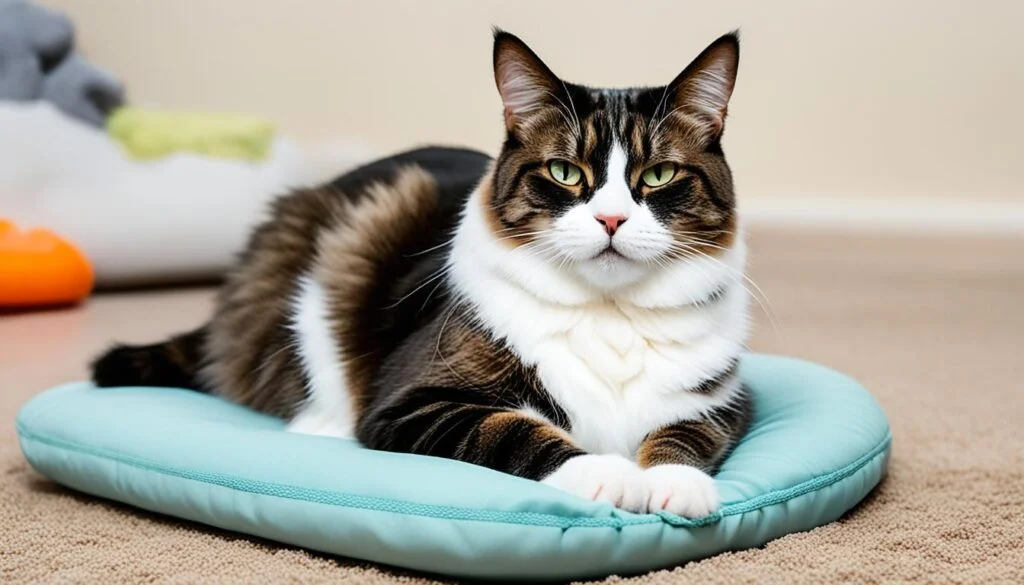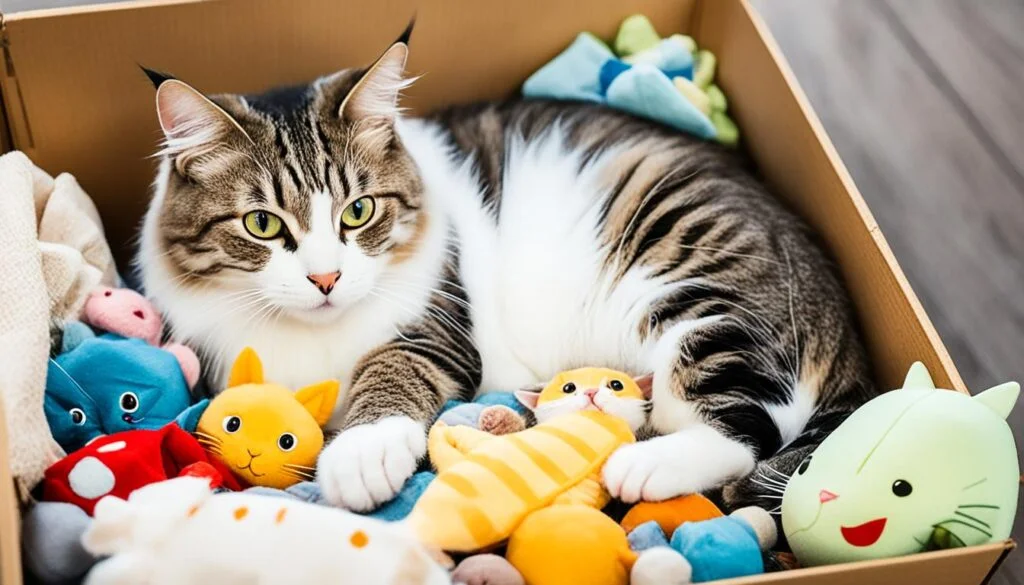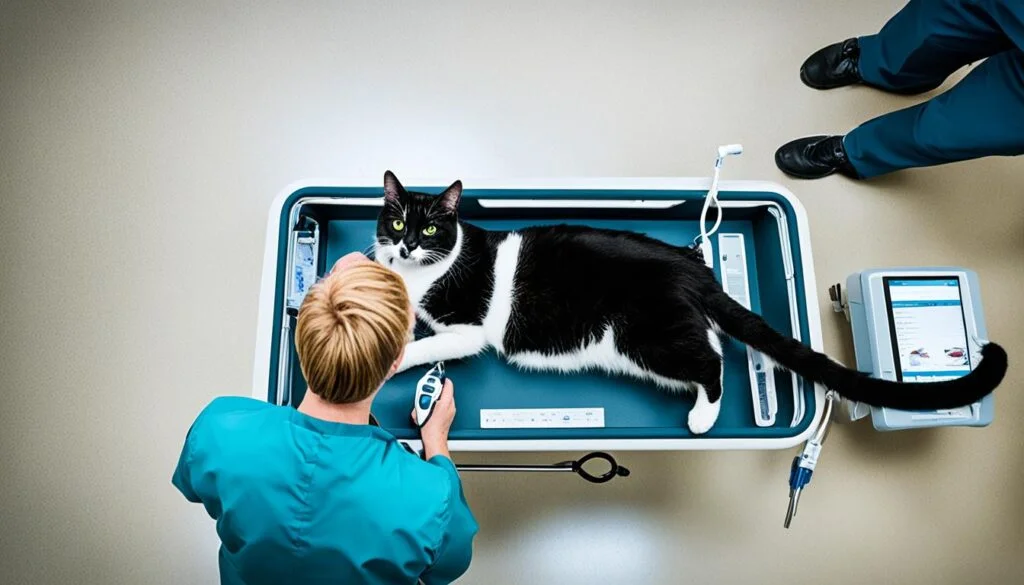Have you ever wondered if your beloved feline friend is expecting kittens? Cats can be quite secretive about their pregnancies, but there are some telltale signs that can help you determine if your cat is pregnant. From physical changes in their body to behavioral alterations, these indicators can give you insights into your cat’s pregnancy status. So, how can you tell if a cat is pregnant? Let’s explore the signs of cat pregnancy and learn how to identify if your cat is expecting.
Thank you for reading this post, don't forget to subscribe!Key Takeaways:
- There are physical and behavioral signs that can help you determine if a cat is pregnant.
- Physical changes include swollen nipples and an enlarging abdomen.
- Behavioral alterations can include increased affection and nesting behaviors.
- Consulting a veterinarian is important for confirmation of cat pregnancy.
- Proper care and attention are crucial for maintaining the health and well-being of a pregnant cat.
Understanding Feline Reproduction and Gestation
Feline reproduction is a fascinating process that involves a series of intricate biological events. To fully comprehend the gestation period in cats, it is essential to understand the basics of feline reproduction. This section will provide you with an overview of the reproductive anatomy of cats, the process of fertilization, and the development of kittens during pregnancy.
Female cats, also known as queens, have a unique reproductive system specially adapted for reproduction. They have two ovaries that store eggs, which are released during heat cycles, also known as estrous cycles. Unlike many other mammals, cats are induced ovulators, meaning they release eggs only when they mate.
Feline gestation, commonly referred to as cat pregnancy, begins when a male cat, or tom, mates with a receptive queen. During mating, the tom deposits sperm into the queen’s reproductive tract, where it fertilizes the released eggs.
Once fertilization occurs, the zygote (a fertilized egg) undergoes cell divisions and travels through the oviducts to reach the uterus, where implantation takes place. The uterus provides a nurturing environment for the developing embryos, supplying them with nutrients and oxygen.
The gestation period, which refers to the time from fertilization to birth, varies in cats. On average, cat pregnancy lasts approximately 63 to 65 days. However, it is important to note that the length of gestation can vary between individual cats and even individual pregnancies within the same cat.
| Key Points on Feline Reproduction and Gestation |
|---|
| Cats have a unique reproductive system adapted for reproduction. |
| Fertilization occurs in the female cat’s reproductive tract. |
| The gestation period in cats is approximately 63 to 65 days. |
| Individual cats and pregnancies can have variations in gestation length. |
Early Signs of Feline Pregnancy
During the early stages of feline pregnancy, there are several physical changes and behavioral alterations that can indicate a cat is expecting kittens. Recognizing these signs is essential for providing appropriate care and support to the pregnant cat. This section will explore the early signs of feline pregnancy, including both the physical and behavioral aspects.
Physical Changes in Your Cat
One of the first physical changes that may become apparent in a pregnant cat is the enlargement of the nipples. The nipples may become more prominent and begin to look swollen or pinkish in color. This is due to hormonal changes and preparation for nursing the kittens.
Another noticeable physical change is an enlarging abdomen. As the pregnancy progresses, the cat’s belly will become rounder and more pronounced. This is because the kittens are growing and developing inside the uterus. It’s important to note that weight gain can also contribute to the enlarging abdomen, so it’s essential to consider other signs alongside this physical change.

Behavioral Alterations Indicative of Pregnancy
In addition to the physical changes, pregnant cats may also exhibit behavioral alterations. One common behavioral change is increased affection towards their human companions. They may seek more attention, enjoy being petted, and show a desire for closeness.
Nesting behaviors are another behavioral alteration that can indicate a cat is pregnant. A pregnant cat may start searching for a comfortable and secure place to give birth to her kittens. This can involve rearranging bedding, exploring secluded areas, and creating a cozy nesting spot.
By observing both the physical changes and behavioral alterations in a cat, it’s possible to identify the early signs of feline pregnancy. These signs provide valuable information for cat owners, allowing them to provide the appropriate care and support for their pregnant cat throughout her pregnancy journey.
How to tell if a cat is pregnant? Signs of Cat Pregnancy
If you suspect that your cat may be pregnant, it’s important to know how to tell for sure. By observing the signs of cat pregnancy, you can have a better understanding of your cat’s reproductive status and provide the necessary care. Here are some key indicators to look out for:
Visual Cues: One of the most noticeable signs of cat pregnancy is swollen nipples. As early as three weeks into the pregnancy, you may notice the nipples becoming enlarged and pink. Additionally, cats that are pregnant often experience weight gain and a rounding of their abdomen due to the growing kittens.
Behavioral Changes: Cats that are pregnant may exhibit certain behavioral alterations. They might become more affectionate and seek additional attention from their owners. Some cats also display nesting behaviors, such as rearranging bedding or searching for secluded spots where they can give birth.
While these signs can provide a good indication of pregnancy, it’s essential to consult a veterinarian for professional confirmation. A veterinarian can conduct a physical examination and palpate the abdomen to feel for developing kittens. They may also recommend advanced diagnostics, such as ultrasound or radiography, for a more accurate assessment.
By knowing the signs of cat pregnancy and seeking veterinary guidance, you can ensure the well-being of your pregnant cat and prepare for the arrival of adorable kittens.
Nesting Behaviors as the Due Date Approaches
As the due date for a pregnant cat approaches, she may exhibit nesting behaviors as her maternal instincts kick in. These behaviors are a natural part of preparing for the arrival of kittens and creating a safe and comfortable environment for them.
When it comes to preparing for the arrival of kittens, there are a few important steps you can take to ensure that your cat has everything she needs:
- Provide a quiet and secluded space for your cat to nest. This can be a cozy corner of a room or a designated cat bed or box. Make sure the area is warm and free from drafts.
- Line the nesting area with soft bedding, such as blankets or towels, to provide comfort for your cat and her future kittens.
- Ensure that your cat has easy access to food, water, and a litter box near her nesting area. Pregnant cats may not want to venture too far from their nest, so it’s important to keep these essentials close by.
- Offer plenty of love and attention to your pregnant cat. She may seek extra affection and reassurance during this time, so be sure to provide her with the care and attention she needs.
But have you ever wondered how cats choose their nesting spots? It turns out that cats have their own unique preferences and considerations when it comes to selecting a location for their nest. Cats may choose a nesting spot based on the following factors:
- Privacy: Cats prefer secluded areas where they can feel safe and secure during the birthing process.
- Comfort: Cats will seek out soft and warm surfaces for their nest, such as blankets or soft furnishings.
- Familiarity: Cats may choose a spot that they are already familiar with, such as their favorite sleeping spot or a quiet corner of the house.
- Quietness: Cats prefer peaceful environments with minimal noise and disruption.
Understanding these nesting behaviors and considerations can help you create a suitable nesting area for your pregnant cat and ensure her comfort during this crucial time.

Detecting Feline Pregnancy Through Veterinary Methods
Physical Examination by a Veterinarian
A physical examination by a veterinarian is one of the essential methods for detecting feline pregnancy. During the examination, the veterinarian will carefully palpate the cat’s abdomen to feel for changes in the uterus and the presence of developing kittens. This method allows the veterinarian to assess the size, shape, and texture of the uterus, providing a reliable indication of pregnancy.
This physical examination also involves assessing other physical symptoms and signs that may indicate pregnancy, such as changes in mammary gland development or the presence of fetal movement. Veterinarians are trained to perform accurate examinations and can provide professional insights based on their expertise.

Advanced Diagnostics: Ultrasound and Radiography
In addition to physical examination, advanced diagnostic methods like ultrasound and radiography can be used to confirm and monitor feline pregnancy more accurately.
Ultrasound is a non-invasive technique that uses sound waves to produce real-time images of the cat’s internal structures. It allows veterinarians to visualize the developing kittens in the uterus, assess their viability, and estimate the gestational stage.
Radiography, also known as X-ray imaging, can provide valuable insights into feline pregnancy. It is commonly used in later stages of gestation to determine the number of kittens and identify potential complications, such as abnormal fetal positioning or skeletal abnormalities. Radiography can also help predict the approximate due date by evaluating fetal development.
These advanced diagnostic techniques enhance the accuracy of pregnancy detection and aid in monitoring the health and well-being of both the mother and the kittens.
Caring for a Pregnant Cat
Proper care during pregnancy is essential to ensure the health and well-being of a pregnant cat. This section will provide valuable information on how to care for a pregnant cat, covering various aspects including nutrition, exercise, grooming, and veterinary care.
Nutritional Needs
Caring for a pregnant cat means paying close attention to her nutritional needs. Provide her with a balanced and high-quality diet specifically formulated for pregnant cats. It should contain essential nutrients such as proteins, fats, carbs, vitamins, and minerals to support her and the developing kittens. Consult with your veterinarian to determine the appropriate feeding schedule and quantity based on her specific needs.
Exercise and Activity
While pregnant, a cat may naturally become less active. Encourage gentle exercise and play to keep her stimulated and maintain muscle tone. Avoid activities that are too strenuous or may cause injury. Provide her with a comfortable and safe environment to move around and rest as she needs.
Grooming and Hygiene
Regular grooming is essential for a pregnant cat’s comfort and cleanliness. Brush her fur gently to remove any tangles or mats. Pay extra attention to her lower belly and nipples, as they may become more sensitive during pregnancy. Ensure her bedding is clean and comfortable, and provide her with a quiet and secluded area where she can rest undisturbed.
Veterinary Care
Regular veterinary check-ups are crucial for the health of a pregnant cat. Schedule visits with your veterinarian to monitor her progress, address any concerns, and ensure a smooth pregnancy. Your vet may also recommend additional vaccinations or preventive treatments to protect both the mother and the unborn kittens.
Caring for a pregnant cat involves providing love, attention, and a safe environment. Be observant and monitor any changes in her behavior or health. If you have any concerns or questions, always consult with your veterinarian for professional advice.
Nutritional Guidelines for a Pregnant Cat
| Nutrient | Importance | Sources |
|---|---|---|
| Protein | Essential for tissue development | Lean meats, poultry, fish |
| Fats | Provide energy and support brain development | Fish oil, chicken fat |
| Carbohydrates | Source of energy | Whole grains, vegetables |
| Vitamins and Minerals | Support overall health | Fruits, vegetables, supplements |
| Water | Prevent dehydration and maintain hydration | Fresh and clean water |
What to Do When Labor Begins
When a cat goes into labor, it is important for pet owners to be prepared and knowledgeable about what to expect. This section will provide guidance on how to handle feline labor and delivery, as well as how to monitor for potential complications during the birth.
Stages of Feline Labor and Delivery
Feline labor typically consists of three stages, each with its own unique characteristics and signs to be aware of.
- Stage 1: Early Labor – During this stage, your cat may exhibit restlessness, nesting behavior, and a loss of appetite. She may also experience mild contractions, which may go unnoticed. This stage can last between 12 to 24 hours.
- Stage 2: Active Labor – In stage 2, the actual delivery of kittens begins. Your cat may experience stronger contractions and visible signs of straining. The time between the delivery of each kitten can vary, but it is typically around 10 to 60 minutes. It is important not to interfere during this stage unless complications arise.
- Stage 3: Placenta Delivery – After the birth of each kitten, your cat will pass the placenta. This ensures that the entire litter has been delivered. It is important to count the number of placentas to ensure they all pass. If a placenta or multiple placentas are retained, it can lead to complications and require veterinary assistance.
Monitoring for Complications During Birth
While most feline births proceed without complications, it is crucial to be vigilant and prepared for any potential issues that may arise. Some common complications that can occur during cat labor include:
- Dystocia – Difficult or prolonged labor
- Uterine Inertia – Weak or absent contractions
- Malposition or Malpresentation – Kittens positioned incorrectly in the birth canal
- Stillbirth – Kittens that are born dead
- Maternal Health Issues – Pre-existing conditions or postpartum complications
To ensure the safety of both the mother cat and kittens, it is essential to monitor the progress of labor and seek veterinary assistance if any complications are suspected. A veterinarian can provide guidance and necessary interventions to address issues that may arise during the birthing process.

Considerations for Unplanned or Unexpected Pregnancies
Dealing with unplanned or unexpected cat pregnancies can be a challenging situation for pet owners. It is important to address these situations with care and consideration to ensure the well-being of both the mother cat and the potential kittens. Here are some key considerations and options to explore:
Spaying and neutering: One of the most effective ways to prevent unplanned cat pregnancies is to have your cat spayed or neutered. Spaying is the surgical removal of a female cat’s reproductive organs, while neutering is the removal of the testes in male cats. These procedures not only prevent unwanted pregnancies but also offer a range of health benefits for your cat.
Adoption: If you find yourself facing an unexpected cat pregnancy and are unable to care for the kittens, adoption can be a viable option. There are many individuals and organizations that specialize in finding loving homes for kittens. By opting for adoption, you are ensuring that the kittens will have a safe and caring environment to grow up in.
Finding suitable homes: Another option for dealing with unexpected cat pregnancies is to find suitable homes for the kittens. This can involve reaching out to friends, family, or local communities to see if anyone is interested in adopting a kitten. Taking the time to vet potential adopters ensures that the kittens will be placed in responsible and loving homes.
It is essential to seek advice from a veterinarian when faced with an unexpected cat pregnancy. They can provide guidance on the best course of action based on your specific circumstances and the health of the mother cat. Remember, early intervention and proactive decision-making are key to ensuring the welfare of both the mother cat and the kittens.
Comparison chart for considerations of unplanned or unexpected cat pregnancies
| Considerations | Spaying and Neutering | Adoption | Finding Suitable Homes |
|---|---|---|---|
| Effectiveness in preventing pregnancies | High | N/A | N/A |
| Health benefits for the cat | Yes | N/A | N/A |
| Ensures kittens have safe and caring environment | N/A | Yes | Yes |
| Requires assistance from professionals or organizations | N/A | Yes | Yes |
Table: A comparison chart highlighting the key considerations for dealing with unplanned or unexpected cat pregnancies. The table compares the effectiveness of spaying and neutering in preventing pregnancies, the health benefits for the cat, and the options of adoption and finding suitable homes for the kittens.
Conclusion
Identifying the signs of cat pregnancy is crucial for the well-being of both the mother cat and her unborn kittens. Throughout this article, we have explored the various indicators of feline pregnancy, including physical changes in the cat’s body and behavioral alterations. By paying attention to these signs, cat owners can determine if their furry friend is expecting and provide the necessary care.
Consulting a veterinarian is essential for confirming a cat’s pregnancy. A physical examination, including palpation of the abdomen, can provide initial confirmation, while advanced diagnostics such as ultrasound and radiography offer more accurate results.
Once pregnancy is confirmed, it is important to provide proper care for the pregnant cat. This includes meeting her nutritional needs, ensuring regular exercise, maintaining grooming routines, and scheduling veterinary check-ups. By following these guidelines, cat owners can help ensure a healthy pregnancy for their feline companion.
In instances of unplanned or unexpected pregnancies, it is crucial to consider the available options. Spaying and neutering can prevent unintended pregnancies, but in the event that it does occur, adoption or finding suitable homes for the kittens are viable solutions. Remember, responsible pet ownership includes taking the necessary steps to prevent and address unplanned pregnancies.





